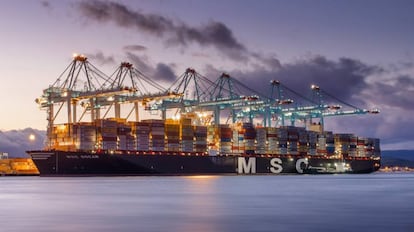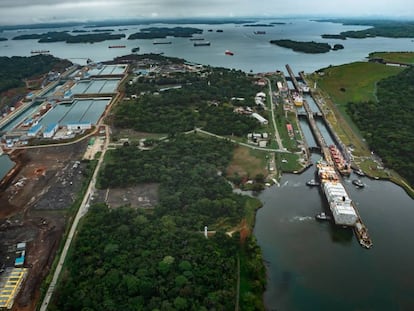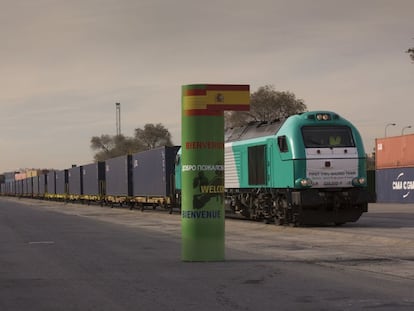Economic recovery sets Spain’s ports on track for a record year
Cruise passengers and container traffic show increase in 2016


The smartphone in your pocket or the computer you use at home probably entered Spain by ship, forming part of the huge number of products that are loaded and unloaded in the country’s ports, which, according to figures for this year are set to break all records for passenger and goods traffic.
If the first half of this year’s performance is repeated in the second six months of 2016, more than 513 million tons of goods will have passed through the 46 ports run by State Ports, which operates under the auspices of the Public Works Ministry, according to data published this week.
More than 30 million passengers have also used these installations, where close to 140,000 ships dock each year. The overall improvement of the Spanish economy, coupled with the consolidation of Spain as a strategic logistics hub, are driving growth.
State Ports says that improvements are needed to Spain’s road and rail infrastructure, citing the Mediterranean rail corridor, which can take goods from Algeciras to anywhere in Europe
During the crisis, Spanish families consumed less, and as a result imports declined. “People weren’t spending, and they just put up with their old television and didn’t want to buy a new car. But as the economy began to take off, consumption has increased, imports and exports have both increased, and all this has impacted on shipping,” says a source at State Ports.
The body says that in the first six months of this year, Spanish ports handled 252 million tons of merchandise, 2.55% more than in the first quarter of 2015, when a total of 502,186, 921 tons were handled. The forecast for this year, based on the performance of the first six months of the year, is 513 million tons. The estimate for 2019 is 560 million.
Spain is also an important trans-shipment point, with around a quarter of goods – some 60.4 million in the first half of this year – unloaded and then taken to other vessels. More than half of this traffic takes place in the port of Algeciras, close to Gibraltar. It is a strategic hub that connects Europe, Africa and America, and is Spain’s most important port.
“Spanish ports and the Iberian peninsula overall have consolidated themselves as a global logistics hub,” says State Ports. “With the opening of the new Panama Canal, a lot of Spanish ports are keen to offer their capacity to the expected increase in traffic between the Americas and Europe.
The ports authority says that Spanish ports still have plenty of capacity. “Between 1992 and 2005, huge investments were made in the country’s installations, more than €1 billion some years. The ports can handle any goods: they are currently working at around 55% installed capacity, and have enough installations to meet increased traffic for the next 20 years.”
State Ports says that improvements are needed to Spain’s road and rail infrastructure, citing the Mediterranean rail corridor, which can take goods from Algeciras to anywhere in Europe, saving shipping companies from having to sail round the western tip of the continent past Portugal and France and onto Rotterdam, still Europe’s biggest port. But Spain lags behind the rest of the EU, where around 15% of goods are taken out of ports by rail: here the figure is around 7.5%.
Sign up for our newsletter
EL PAÍS English Edition has launched a weekly newsletter. Sign up today to receive a selection of our best stories in your inbox every Saturday morning. For full details about how to subscribe, click here
The Public Works Ministry says it expects a record number of passengers entering and leaving Spain by ship for this year: some 30.87 million, up 3% on last year. Around a third of them, 8.59 million, traveled aboard the almost 4,000 cruise ships that now visit Spain each year. Up to June, 12.7 million people had disembarked at a Spanish port, up 5.6% on last year. There has been a particularly large increase in the Balearic Islands, which have seen a 16.3% increase in travelers, most of them using ferries to and from the mainland. But Spain’s number one cruise destination is Barcelona, which received some 2.5 million in 2015. The growing popularity of cruises, which offering highly competitive prices, along with security concerns about Tunisia, Egypt, Turkey, and even Greece, have benefited Spanish ports.
English version by Nick Lyne.
Tu suscripción se está usando en otro dispositivo
¿Quieres añadir otro usuario a tu suscripción?
Si continúas leyendo en este dispositivo, no se podrá leer en el otro.
FlechaTu suscripción se está usando en otro dispositivo y solo puedes acceder a EL PAÍS desde un dispositivo a la vez.
Si quieres compartir tu cuenta, cambia tu suscripción a la modalidad Premium, así podrás añadir otro usuario. Cada uno accederá con su propia cuenta de email, lo que os permitirá personalizar vuestra experiencia en EL PAÍS.
¿Tienes una suscripción de empresa? Accede aquí para contratar más cuentas.
En el caso de no saber quién está usando tu cuenta, te recomendamos cambiar tu contraseña aquí.
Si decides continuar compartiendo tu cuenta, este mensaje se mostrará en tu dispositivo y en el de la otra persona que está usando tu cuenta de forma indefinida, afectando a tu experiencia de lectura. Puedes consultar aquí los términos y condiciones de la suscripción digital.
More information

Panama celebrates newly expanded canal as a patriotic milestone
Archived In
Últimas noticias
The complicated life of Francesca Albanese: A rising figure in Italy but barred from every bank by Trump’s sanctions
How Japan is trying to avert ‘digital defeat’
Reinhard Genzel, Nobel laureate in physics: ‘One-minute videos will never give you the truth’
Pinochet’s victims grapple with José Antonio Kast’s rise in Chile
Most viewed
- Pablo Escobar’s hippos: A serious environmental problem, 40 years on
- Why we lost the habit of sleeping in two segments and how that changed our sense of time
- Trump’s obsession with putting his name on everything is unprecedented in the United States
- The Florida Keys tourist paradise is besieged by immigration agents: ‘We’ve never seen anything like this’
- Charles Dubouloz, mountaineering star, retires at 36 with a farewell tour inspired by Walter Bonatti









































